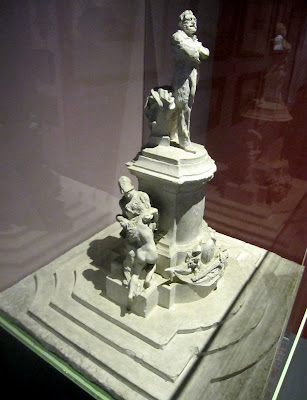 For many years throughout the 20th century, this proud portrayal of statesman Léon Gambetta was the centrepiece of Allées de Tourny in central Bordeaux. What has happened to this monument, which disappeared from view in the 1960s but which can still be spotted on many old postcard views of the city?
For many years throughout the 20th century, this proud portrayal of statesman Léon Gambetta was the centrepiece of Allées de Tourny in central Bordeaux. What has happened to this monument, which disappeared from view in the 1960s but which can still be spotted on many old postcard views of the city? The majestic work was positioned towards the middle of the promenade in 1905. The statue of Gambetta was executed by the sculptor Jules Dalou (1838-1902) while the figures at his feet were designed by Camille Lefèvre, a student of Dalou. The plinth which served as the backdrop to the various features was the work of local architect Jean-Camille Formigé (1845-1926). To pay for the monument, funds were raised nationwide by political supporters who sought to celebrate Léon Gambetta’s legacy.
 |
| The Gambetta monument and the same view today, minus the monument! |
His status as senior statesman was gained during and after the 1870 Franco-Prussian war. Although opposed to the war with Germany, he adopted a patriotic line, urging his colleagues to leave Paris and run the government from the provinces. This was rejected but a delegation to organise resistance was dispatched to Tours. Gambetta left Paris (in a hot air balloon), took control as minister of the interior and of war, and quickly organised an army. Success was impossible however and after the French defeat near Orléans, the seat of government was transferred to the Grand-Théâtre in Bordeaux. In conflict with the prime minister, Gambetta spent time in exile in San Sebastián, Spain, but soon returned to France.
 |
| In the foreground, one of two fountains designed by Mathurin Moreau (see below). |
 |
| President Loubet (third from left in front row) arrives for the unveiling of the monument, 1905. |
Pont d'Aquitaine. It has not been possible to view the monument ever since, other than when the monument came out of hiding for a short period in 1995 when it was put on display outside the museum itself. However, an 80-centimetre-high plaster miniature, produced in 1901 at the same time as the full-scale monument, can be seen among the museum’s permanent exhibits. It was donated to the city of Bordeaux by the committee of Gambetta supporters who had funded the work. Meanwhile, occasional plans surface to reinstate the full-size statue, but at most potential sites (such as Place de la République, by the Palais de Justice), the ground is not robust enough to support its mass.
 |
| Details from the plaster miniature on display at the Musée d'Aquitaine. |
Though initially replaced by two more modest, low-maintenance models, today’s Allées no longer feature any fountains at all. The Moreau fountains are still very much in existence though: one is further up the coast in Soulac-sur-Mer (and in bad need of repair work) while the other has, since 2007, been positioned on a roundabout on Avenue Honoré-Mercier in... Québec City, Canada! Appropriately enough, it is now known as “Fontaine de Tourny”. And back in Bordeaux, Léon Gambetta may no longer be celebrated in the shape of a monument, but the square which was given his name in 1883 remains a central hub of the city: Place Gambetta.
 |
| Allées de Tourny today, and the entrance to the car park which contributed to the removal of the Gambetta monument! |
- Find it: Allées de Tourny, Musée d'Aquitaine, Cours Pasteur, Bordeaux.
- Big thanks to Sophie Ollé-Fontan and Geneviève Depuis-Sabron at Musée d'Aquitaine and Serge Fernandez at Musée des Beaux-Arts who helped me fill in many of the gaps in this story!
- Full information about the fountains and what happened to them on 33-bordeaux.com.
- Another Léon Gambetta statue has led a similarly eventful life in Paris, as reported by Adam over at Invisible Paris!












0 commentaires: